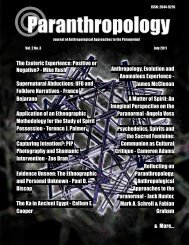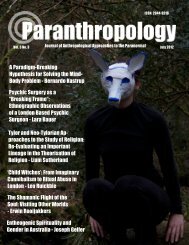Psi and Psychedelics - Paranthropology - Weebly
Psi and Psychedelics - Paranthropology - Weebly
Psi and Psychedelics - Paranthropology - Weebly
You also want an ePaper? Increase the reach of your titles
YUMPU automatically turns print PDFs into web optimized ePapers that Google loves.
PARANTHROPOLOGY: JOURNAL OF ANTHROPOLOGICAL APPROACHES TO THE PARANORMAL VOL. 2 NO. 2<br />
studies suggest that some epileptics, <strong>and</strong><br />
certain very sensitive people, who in our<br />
society sometimes end up being labelled<br />
psychotic, are often chosen for training as<br />
shamans, since they are considered, as a<br />
result of their spiritual emergence<br />
experience, to be linked in some special<br />
way with the world of spirits <strong>and</strong> psi<br />
abilities. People in possession trance also<br />
sometimes appear to be in a state very<br />
similar to certain phases of epilepsy or of,<br />
what is called in the West, psychosis. And<br />
folklore of psychosis links it with the<br />
psychic.<br />
Melatonin has been shown to have an<br />
anti-epileptic effect, epileptics often being<br />
considered to be seers in olden times;<br />
<strong>and</strong>, together with thyrotropin, is involved<br />
in coping with persistent long-term stress.<br />
It is well-known that many shamans <strong>and</strong><br />
mystics will undergo a rigorous training<br />
that puts them under persistent long-term<br />
stress, <strong>and</strong> during this time they tend to<br />
have mystical visions, out-of-body <strong>and</strong><br />
psychic experiences.<br />
Another interesting snippet of<br />
information is that the highest<br />
concentrations of serotonin have been<br />
f o u n d i n t h e p i n e a l g l a n d s o f<br />
schizophrenics. A dysfunction of central<br />
serotonin metabolism in schizophrenia<br />
has been repeatedly suggested as a trigger<br />
for the onset of psychosis; this would fit<br />
in with the cyclic seasonal nature of some<br />
manic-depressives. Melatonin elevates<br />
cerebral serotonin, particularly in the<br />
mid-brain. Schizophrenics often exhibit<br />
sleep disturbances; insomnia may be the<br />
first symptom of a psychotic episode,<br />
while changes in REM sleep <strong>and</strong> in EEG<br />
patterns during sleep have been observed.<br />
Also arousal level, thus implicating the<br />
RAS, is altered in psychotics. All of these<br />
are connected with serotonin <strong>and</strong><br />
melatonin.<br />
And finally, several people have<br />
suggested that the beta-carbolines may<br />
play some sort of role in psychosis since<br />
they have hallucinogenic effects because<br />
of the interaction with serotonin creating<br />
DMT. An acute psychotic episode is<br />
remarkably like a psychedelic experience<br />
gone wild, out-of-control <strong>and</strong> unable to be<br />
stopped. A dream can be as<br />
hallucinogenic as a psychedelic trip;<br />
could it be that the endogenous<br />
psychedelic dream mechanism in our<br />
brains has gone out-of-order for people in<br />
psychosis?<br />
For more detail about this topic please go<br />
to my web site where there is an article<br />
called “Walking Between the Worlds”<br />
which can be downloaded. 38<br />
Conclusion<br />
As yet there is no clear brain functioning<br />
linked with psychological aspects of<br />
psychic functioning. However, the pieces<br />
of the puzzle are turning up <strong>and</strong> the<br />
picture is becoming clearer, <strong>and</strong> the<br />
information I have presented here<br />
validates a lot of folk <strong>and</strong> magical lore<br />
concerning psychic functioning. Although<br />
it is at present unclear as to the exact<br />
mechanism within the brain of the pineal<br />
chemicals, <strong>and</strong> their exact effects on our<br />
state of consciousness <strong>and</strong> behaviour, this<br />
t h e s i s c o u l d l e a d t o a g r e a t e r<br />
underst<strong>and</strong>ing of the physiological<br />
process underlying certain psiconducive<br />
states of consciousness.<br />
Notes<br />
1. e.g. Honorton (1977); Braud <strong>and</strong> Braud<br />
(1974), Krippner, Honorton <strong>and</strong> Ullman<br />
(1972). The original version of this<br />
chapter was published in the Journal of<br />
31 PARANTHROPOLOGY: JOURNAL OF ANTHROPOLOGICAL APPROACHES TO THE PARANORMAL




